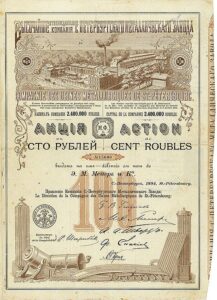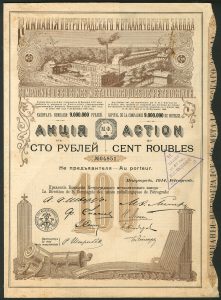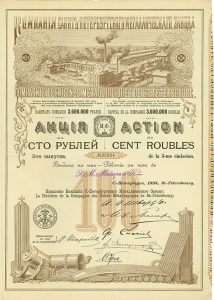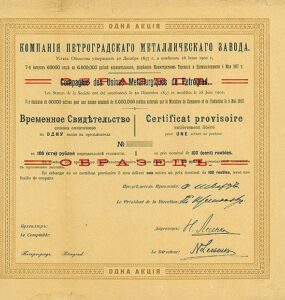
Compagnie des Usines Métallurgiques de St.-Pétersbourg / Pétrograde
Компания Санктъ-Петербургскаго Металлическаго Завода
Other city spellings: St.-Pétersbourg, Petrograd, Pétrograde
Formed in 1857 with head office in St. Petersburg. Initial capital was 2,400,000 roubles and by 1898, capital had increased to 3,600,000 roubles. Capital was increased in 1914 to 9,000,000 roubles, all in shares of 100 roubles.
The name of the company was changed in 1916 to Compagnie des Usines Métallurgiques de Pétrograde.
1857
Description
Originally, this factory was a small enterprise producing iron household goods. In 1858, the merchant of the 1st guild, S. N. Rasteryayev, bought the factory and founded a joint-stock company called “Compagnie der St. Petersburg Metallwerke” on its basis. Petersburg bankers were among the founders and financiers, above all the private banking house Edward Morice Meyer & Co. and the Jewish banking house Wawelberg. Initially, the new company produced iron and copper wire, nails and various materials for railway construction, followed by more complicated products , e.g. boilers for heating buildings, lattice masts, ceiling beams for roof constructions. For example, the lattice glass roof of the GUM department store in Moscow was one of the much admired constructions of the metal works. A large number of railway bridges over the Moskva , the Oka, the Volga and other rivers across the country were built by the metal works, armaments also took with them an important place in production at the time, e.g. gun carriages, turrets for warships and armored vehicles. The most advanced products were – but this was already in the 20th century – steam turbines. Even after the communist revolution, turbine construction remained the main product in which the Leningrad Metal Works (LMZ for short), as they were later called, specialized. With the construction of turbines, the metal works have remained one of the largest mechanical engineering companies in St. Petersburg to this day. (Source: HWPH, October 2013)




